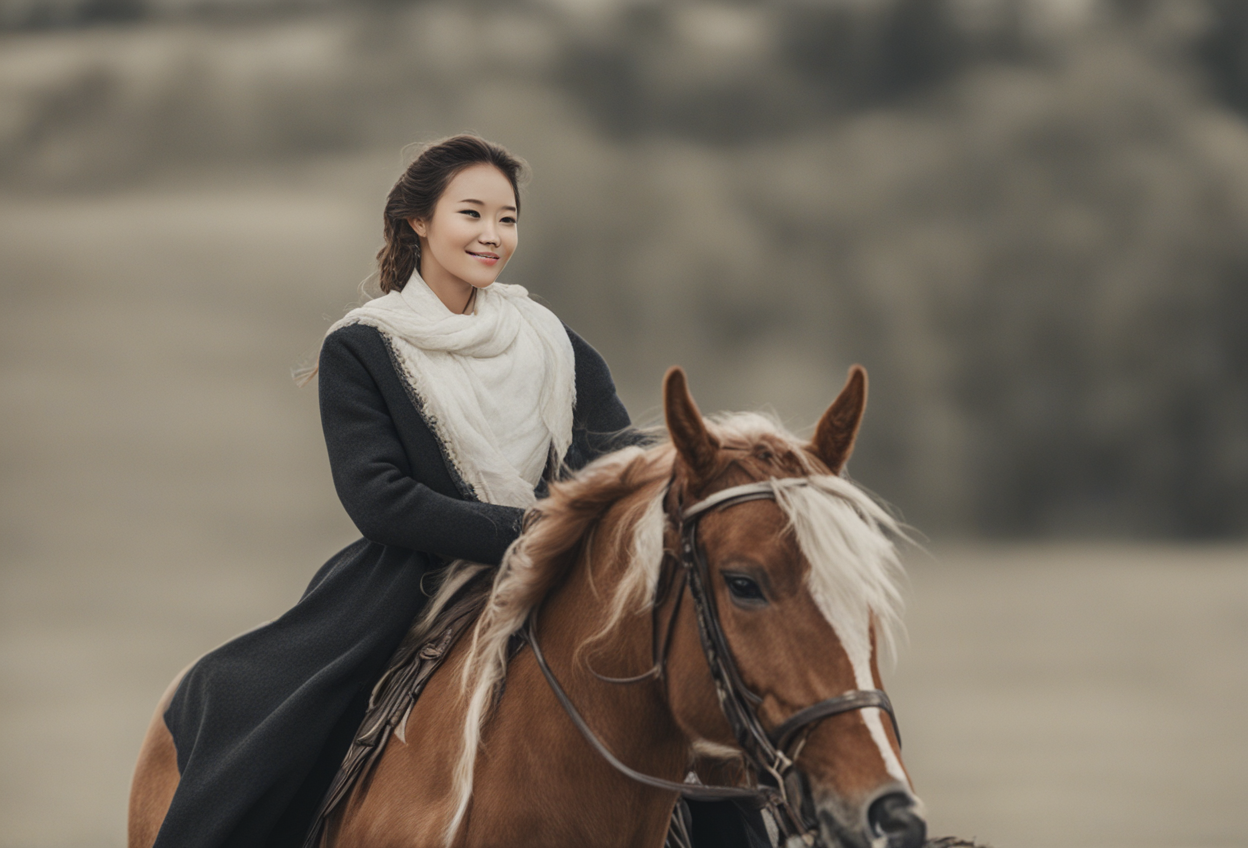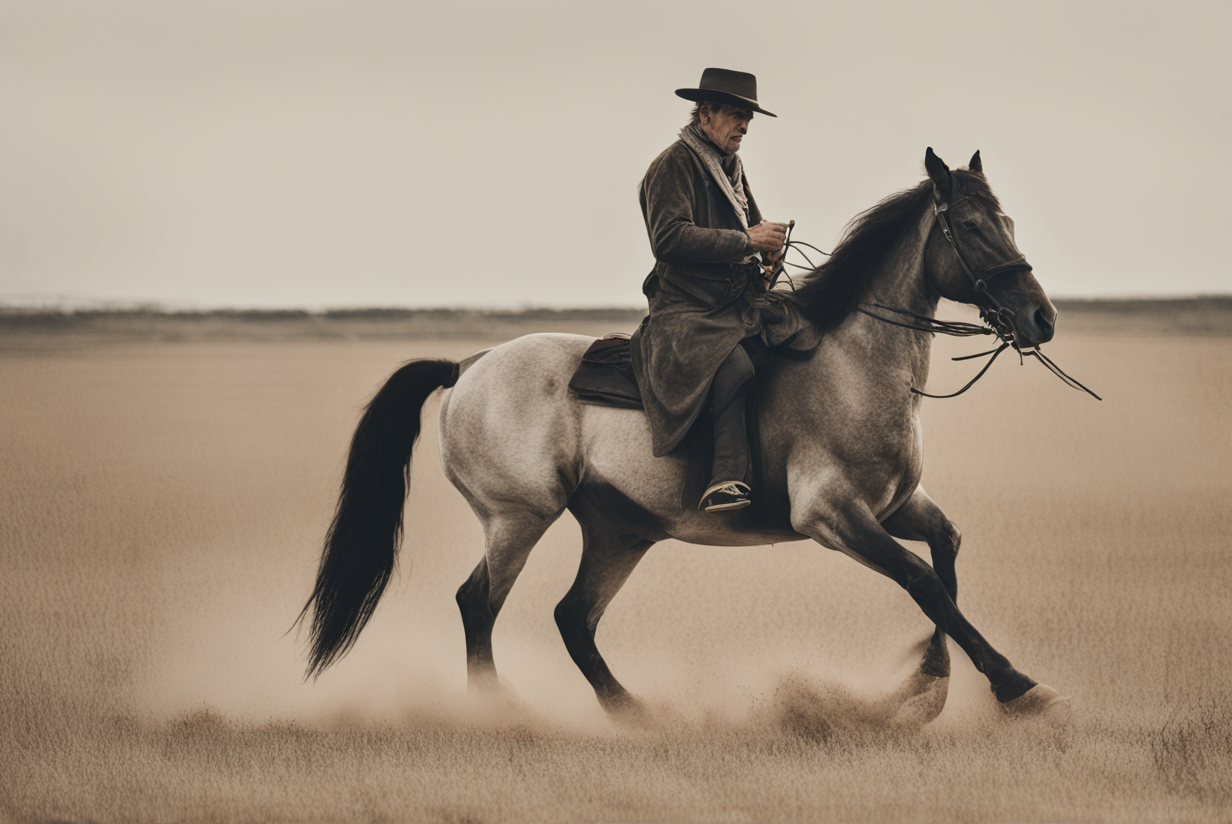As a kid I always thought it was so cool that horses would just let us hop on their backs and go for a ride.
Like how did they know we wouldn’t hurt them?
Now after years of being around horses, I’ve learned a thing or two about why our equine friends are so chill with us in the saddle:
Table of Contents
Domestication Did the Trick

Horses have been domesticated for over 6,000 years, starting with the people of the Eurasian steppe in around 4000 BC. These early civilizations utilized a process called selective breeding—they deliberately chose to breed horses with calm temperaments that took well to training.
Generation after generation, only the gentlest horses were selected for reproduction, slowly changing horses’ instincts over hundreds of years until today’s domesticated horses were developed.
But domestic horses’ ancestors were conditioned over millennia to view people as family rather than threats.
Their fight or flight response dulled, replaced with a genetic memory that humans provide protection, food and stable social bonds.
Today’s horses remain very tolerant of human contact like grooming, leading and yes, even carrying our weighty selves across fields thanks to the results of careful breeding long ago.
Their trusting nature really does stem from the selective pressures exerted by our prehistoric ancestors seeking equine companions.
Food is a Great Motivator!

Domestic horses understand that people bring them nourishment, as they’ve been fed by our hands for thousands of years. And no creature wishes to bite that hand!
From the moment they’re born, foals learn humans equal yummy grain and hay. They associate our touch with good feelings like full bellies.
Owners reinforce this tie further by rewarding good behavior with tidbits—a little something extra for standing nice and still for the farrier or vet.
Treats are a natural way to motivate horses through positive reinforcement ever since kids first fed horses carrot sticks in medieval times.
So when we saddle up, horses anticipate the delicious goodness to come after our ride. A full tummy keeps even the grumpiest mare quite agreeable!
We keep their trust by keeping their feed buckets brimming with nourishing chow. Food really is fundamental to the human-horse bond.
It’s What They’re Trained For Dude

Training begins young for domesticated horses, usually starting under saddle between ages 3 to 5 years old.
Using gentle handling and positive reinforcement techniques, trainers systematically desensitize foals to human contacts like grooming, tacking, and eventually a rider sitting on their backs.
Lunging teaches them to pay attention to cues to change direction and gait, building the foundation of control and communication.
Clicker training links desirable behaviors to an audible reward, like nickering in response to a leg cue being immediately paired with a treat.
Graduated exposure gets horses accustomed to the unusual sensation of having weight shift on different parts of their bodies via skilled riders.
Over months, carrying a rider transitions from something novel to an everyday normal activity, all because of how trainers carefully socialize them as youngsters.
So when you mount up, your horse accepts the saddle as the natural next step thanks to their positive early schooling experiences.
They’re Not As Fragile As They Look
Standing around 4 feet tall at the withers, horses can seem dainty animals for their size.
But make no mistake – they’re built tough underneath those slender legs. Their bodies are actually finely tuned athletic machines.
A horse’s skeleton is 70% dense bone for strength and support. Strong vertebrae allow for flexible yet protected spines.
Broad chests contain mighty hearts that can pump over 25 gallons of blood per minute at full gallop.
And those seemingly spindly legs end in leathery hooves encasing thick tissues that make horses’ footfalls quiet as any cat.
Their backs also contain interlocking vertebrae allowing for around 200 pounds of rider weight distribution without pinching nerves or muscles.
With bones denser than ours, horses can carry 20-30% of their body weight for miles on end across any terrain.
So rest assured Fido, old Paint can easily hold your scruffy behind all day without complaining a bit. These are animals built for locomotion and load!
We Speak Their Language
Like any social species, horses communicate in their own subtle, sophisticated tongue.
Through years of study, top horsemen have learned to interpret the facial expressions, ear positions, tail swishes and other signs that clue equine emotions and intentions.
More importantly, competent riders become fluent in the primary language horses truly understand – cues given through our seated position, legs, hands and voice tone to direct their movement.
By utilizing aids such as squeezing with the calves to go forward or pulling back gently on the reins to halt, we invoke immediate learned reactions.
With consistent, clear signals, horses learn the “words” that make up dressage tests, jumping courses or leisurely trail rides.
As long as communication stays respectful yet commanding, horses feel confident following a rider’s leadership based on a common vocabulary they’ve been acculturated to since early experiences.
No babel – just smooth sailing when both horse and human understand each other perfectly.
Trust is a Two Way Street Dude
Horses have radar-like senses tuning into emotional states, a skill essential on the plains to avoid danger.
They can identify fear or disquietude within a person from subtle muscle tension or rapid breathing well before we even notice.
An insecure rider broadcasts instability, undermining the horse’s faith their commander won’t abruptly steer them wrong.
And horses don’t like feeling out of control of situations any more than us humans do!
That’s why gaining equine confidence requires developing your own self-assurance first.
Approach calmly, make eye contact, give praise and keep motions gradual to earn a horse’s trust in your decision making.
Let them feel secure in you as their leader through patience and respect for their sensitive nature.
In return, they’ll lend themselves willingly to help you fulfill whatever equestrian dreams you set your mind to.
Leadership’s a collaborative effort, and horses want confident partners to depend on just as much as we depend on their strength and spirit.
It’s in Their Nature To Please
Through millennia adapting alongside early humans, modern domesticated horses share behavioral traits with tamed canines.
Specifically, horses evolved neurological responses tuning into nuanced human body language and facial expressions.
They seem to intrinsically crave the approving glance, friendly rub or carrot bestowed by humans in exchange for good conduct.
From a young age, horses actively seek this positive interaction by mimicking behaviors their mothers demonstrate to gain the band’s acceptance and security.
Approval-seeking wiring makes them highly motivated to learn and perform tricks to solicit attention, grooming or snacks from their herd’s symbiotic partners.
Genetics plus conditioning shape horses into cheerful companions naturally predisposed to form strong social attachments with people.
Their eager-to-please nature emerges untrained and serves the relationship well, making instruction and riding a delight for horse and human alike.
We Provide Protection
Life on the plains posed constant threats from predators, harsh weather and human rivals.
Ancient wild horses relied heavily on their herds’ sentinels to detect and ward off looming dangers.
By allowing early man into their social circles, horses gained vigilant guardians equipped with superior senses, tools and tactics.
People helped guide herds to shelter, water and prime grazing lands away from conflicts while standing watch.
This symbiosis kept horses and humans alive during trying eras and is hardcoded in domestic horses’ psyche even today.
Riders are Their Leaders
A horse’s herd is led by a dominant mare and horses are naturally inclined to follow a leader.
When humans gain horses’ trust through positive reinforcement training, horses view them as members of their herd.
They recognize riders as the alpha providing direction just as the lead mare would.
By cuing horses with seat, legs and voice, riders guide them as intelligent herd animals want – following clear instruction.
Submission to the rider’s leadership allows horses freedom within safe boundaries and structure they find psychologically reassuring.
Their prey instincts tuned to flee threats relax under the safety provided by human caretakers standing in as herd protectors.
Letting us take command supports horses’ natural social order they’ve evolved for millennia to feel secure living within.
We Satisfy Their Needs
Like any domestic animal, horses thrive when their physical and mental requirements are met.
Through understanding equine psychology, riders fulfill horses’ drives for exercise, mental stimulation, social interaction and purpose.
Daily work under saddle challenges them athletically while engaging their clever problem-solving brains.
Pastured with fellow equines, horses also find herd bonds easing anxiety just as critical as forage and shelter.
Caring owners spend quality one-on-one time massaging worries away through bonding activities such as grooming.
Escorting horses on trails immerses them in nature’s calming sights and smells too.
Successfully partnering with their human allows horses to live happy, healthy lives doing what they love at our side.
Riding is Routine Activity
Through generations of domestication, horses adapt genetically to human handling.
From their first days, foals experience hugs, hair brushing and soon saddle training as ordinary occurrences.
Carrying a rider’s weight blends into normal daily physical activity no different than the exercise of grazing freely.
With competent instruction, horses view working under saddle as play rather than unfathomable chore.
Riding ties into their natural herd instincts to follow confident leaders across landscapes just as wild horses once did.
Engaging mentally and physically, riding triggers horses’ pleasure hormones making the task intrinsically rewarding.
Far from onerous labor, permitting riders denotes cooperation with the social lifestyle horses know best.
They Bond with Their People
Horses exhibit strong, affectionate relationships comparable to human companionship.
Through daily care, training and partnership, attachments form based on mutual trust and respect.
They recognize familiar people, nickering greetings or soliciting grooming sessions for endorphin-releasing human touch.
Owners learn each horse’s unique personality quirks and preferences through observant quality time.
In return, horses accept humans as integral packmates providing for their wellbeing just as other equines do.
Letting treasured people ride signifies faith these beloved herd members won’t abuse power over them.
The unbreakable bonds horses build ensure willing cooperation and lifetimes of loyal friendship.
Riding is Fun!
With proper socialization and instruction, horses revel in physical and mental challenges.
Jumping logs, navigating trails and completing obstacle courses engage their playful spirits.</
Competitive creatures, they relish contests of speed, agility and the thrill of conquering fears.
Riders provide entertainment through Adventure, along with rewards reinforcing pleasure responses.
Together, horse and human form a perfect athletic partnership for play-filled days of discovery.
By willingly letting us partake in leisurely pleasure alongside them, horses share in joy that strengthens the bond.
Their willingness signals that like humans, horsey hearts simply can’t resist a good time!